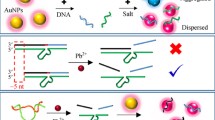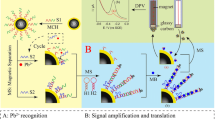Abstract
Strontium-90 (90Sr) is a major radioactive component that has attracted great attention, but its detection remains challenging since there are no specific energy rays indicative of its presence. Herein, a biosensor that is capable of rapidly detecting Sr2+ ions is demonstrated. Simple colorimetric method for sensitive detection of Sr2+ with the help of single-stranded DNA was developed by preparing MnO2 nanorods as oxidase mimic catalysis 3,3′,5,5′-tetramethylbenzidine (TMB). Under weakly acidic conditions, MnO2 exhibited a strong oxidase-mimicking activity to oxidize colorless TMB into blue oxidation products (oxTMB) with discernible absorbance signals. Nevertheless, the introduction of a guanine-rich DNA aptamer inhibited MnO2-mediated TMB oxidation and reduced oxTMB formation, resulting in blue fading and diminished absorbance. Upon the addition of strontium ions to the system, the aptamers formed a stable G-quadruplex structure with strontium ions, thereby restoring the oxidase-mimicking activity of MnO2. Under the best experimental conditions, the absorbance exhibits a linear relationship with the Sr2+ concentration within the range 0.01–200 μM, with a limit of detection of 0.0028 µM. When the concentration of Sr2+ from 10−8 to 10−6 mol L−1, a distinct color change gradient could be observed in paper-based sensor. We successfully applied this approach to determine Sr2+ in natural water samples, obtaining recoveries ranging from 97.6 to 103% with a relative standard deviation of less than 5%. By providing technical solutions for detection, our work contributed to the effective monitoring of transportation of radioactive Sr in the environment.
Graphical abstract








Similar content being viewed by others
Data Availability
All data generated or analyzed during this study are included in this published article (and its supplementary information files). The datasets used and/or analyzed during the current study are available from the corresponding author on reasonable request.
References
Kim G, Choi S-D, Lim J-M, Kim H (2023) Strontium-90 levels in seawater southeast of Jeju Island during 2021–2023. Mar Pollut Bull 193:115258. https://doi.org/10.1016/j.marpolbul.2023.115258
Korsakov AV, Golovleva AA, Troshin VP et al (2021) Ovarian malignancies frequency in the female population from the bryansk region living in conditions of radioactive, chemical and combine contamination (2000–2020). Life 11:1272. https://doi.org/10.3390/life11111272
Tolstykh EI, Shagina NB, Degteva MO (2014) Increase in accumulation of strontium-90 in the maternal skeleton during pregnancy and lactation: analysis of the Techa River data. Radiat Environ Biophys 53:551–557. https://doi.org/10.1007/s00411-014-0548-3
Abd Elkader RS, Mohamed MK, Hasanien YA, Kandeel EM (2023) Experimental and modeling optimization of strontium adsorption on microbial nanocellulose, eco-friendly approach. J Clust Sci. https://doi.org/10.1007/s10876-023-02454-3
He Y, Chen Y-G, Ye W-M (2016) Equilibrium, kinetic, and thermodynamic studies of adsorption of Sr(II) from aqueous solution onto GMZ bentonite. Environ Earth Sci 75:807. https://doi.org/10.1007/s12665-016-5637-y
Singh BSM, Dhal NK, Kumar M et al (2023) Retaliation of Alstonia scholaris (L.) R.Br. to caesium and strontium in hydroponics: effect on morpho-physiology and induction of enzymatic defence. Environ Monit Assess 195:703. https://doi.org/10.1007/s10661-023-11304-8
Alam MNE, Hosen MM, Ullah AKMA et al (2023) Pollution characteristics, source identification, and health risk of heavy metals in the soil-vegetable system in two districts of Bangladesh. Biol Trace Elem Res 201:4985–4999. https://doi.org/10.1007/s12011-023-03558-7
Feng L, Wang H, Liu T et al (2023) Ultrasensitive and highly selective detection of strontium ions. Nat Sustain 6:789–796. https://doi.org/10.1038/s41893-023-01095-8
Ebrahimi N, Raoof JB, Ojani R, Ebrahimi M (2023) Electrochemical aptasensor based on carboxylated graphene oxide modified carbon paste electrode for strontium ultrasensitive detection. Anal Biochem 666:115081. https://doi.org/10.1016/j.ab.2023.115081
Xu D, Chen L, Dai X et al (2020) A Porous aromatic framework functionalized with luminescent iridium(III) organometallic complexes for turn-on sensing of 99TcO4–. ACS Appl Mater Interfaces 12:15288–15297. https://doi.org/10.1021/acsami.0c01929
Kang H, Min S, Seo B et al (2021) Preliminary studies of perovskite-loaded plastic scintillator prototypes for radioactive strontium detection. Chemosensors 9:53. https://doi.org/10.3390/chemosensors9030053
Zhuo Z, Yu Y, Wang M et al (2017) Recent advances in SELEX technology and aptamer applications in biomedicine. Int J Mol Sci 18:2142. https://doi.org/10.3390/ijms18102142
Li X, Huang Z, Li S et al (2020) A new approach to construct and modulate G-quadruplex by cationic surfactant. J Colloid Interface Sci 578:338–345. https://doi.org/10.1016/j.jcis.2020.06.012
Qi Y, Chen Y, Xiu F-R, Hou J (2020) An aptamer-based colorimetric sensing of acetamiprid in environmental samples: convenience, sensitivity and practicability. Sens Actuators B Chem 304:127359. https://doi.org/10.1016/j.snb.2019.127359
Tang Y, Hu Y, Zhou P et al (2021) Colorimetric detection of kanamycin residue in foods based on the aptamer-enhanced peroxidase-mimicking activity of layered WS2 nanosheets. J Agric Food Chem 69:2884–2893. https://doi.org/10.1021/acs.jafc.1c00925
Jin B, Wang S, Lin M et al (2017) Upconversion nanoparticles based FRET aptasensor for rapid and ultrasenstive bacteria detection. Biosens Bioelectron 90:525–533. https://doi.org/10.1016/j.bios.2016.10.029
Hyuk Jang D, Young Lee S, Kim H, Yun M (2024) Selection of a nickel-specific DNA aptamer and development of a protocol for radioactive nickel removal. Ann Nucl Energy 195:110138. https://doi.org/10.1016/j.anucene.2023.110138
Nicholson DA, Nesbitt DJ (2023) Kinetic and thermodynamic control of G-quadruplex polymorphism by Na+ and K+ cations. J Phys Chem B 127:6842–6855. https://doi.org/10.1021/acs.jpcb.3c01001
Kankia BI, Marky LA (2001) Folding of the thrombin aptamer into a G-quadruplex with Sr2+: stability, heat, and hydration. J Am Chem Soc 123:10799–10804. https://doi.org/10.1021/ja010008o
Ida R, Wu G (2008) Direct NMR detection of alkali metal ions bound to G-quadruplex DNA. J Am Chem Soc 130:3590–3602. https://doi.org/10.1021/ja709975z
Liu J, Niu X (2022) Rational design of nanozymes enables advanced biochemical sensing. Chemosensors 10:386. https://doi.org/10.3390/chemosensors10100386
Qi Y, Wang Y, Chen Y et al (2022) Rapid color-fading colorimetric sensing of Hg in environmental samples: regulation mechanism from DNA dimension. Microchim Acta 189:76. https://doi.org/10.1007/s00604-022-05177-w
Gao L, Zhuang J, Nie L et al (2007) Intrinsic peroxidase-like activity of ferromagnetic nanoparticles. Nat Nanotechnol 2:577–583. https://doi.org/10.1038/nnano.2007.260
Shi Y, Liu Z, Liu R et al (2022) DNA-encoded MXene-Pt nanozyme for enhanced colorimetric sensing of mercury ions. Chem Eng J 442:136072. https://doi.org/10.1016/j.cej.2022.136072
Zhu X, Tang J, Ouyang X et al (2022) Hollow NiCo@C nanozyme-embedded paper-based colorimetric aptasensor for highly sensitive antibiotic detection on a smartphone platform. Anal Chem 94:16768–16777. https://doi.org/10.1021/acs.analchem.2c03603
Zhang Y, Zeng X, Jiang X et al (2019) Ce-based uio-66 metal-organic frameworks as a new redox catalyst for atomic spectrometric determination of se(vi) and colorimetric sensing of hg(ii). Microchem J 149:103967. https://doi.org/10.1016/j.microc.2019.103967
Wan Y, Qi P, Zhang D et al (2012) Manganese oxide nanowire-mediated enzyme-linked immunosorbent assay. Biosens Bioelectron 33:69–74. https://doi.org/10.1016/j.bios.2011.12.033
Wang X, Chen M, Zhao L (2023) Development of a colorimetric sensing assay for ascorbic acid and sarcosine utilizing the dual-class enzyme activity of Fe3O4@SiO2@NiCo2S4. Chem Eng J 468:143612. https://doi.org/10.1016/j.cej.2023.143612
Sun W, Feng L, Zhang J et al (2022) Amidoxime group-anchored single cobalt atoms for anti-biofouling during uranium extraction from seawater. Adv Sci 9:2105008. https://doi.org/10.1002/advs.202105008
Lu M, Lu Y, Qiu K et al (2016) One-pot synthesized ultrathin MnO2 nanorods as advanced electrodes for high-performance supercapacitors. Mater Lett 166:255–258. https://doi.org/10.1016/j.matlet.2015.12.099
Mallakpour S, Motirasoul F (2017) Bio-functionalizing of α-MnO2 nanorods with natural l-amino acids: a favorable adsorbent for the removal of Cd(II) ions. Mater Chem Phys 191:188–196. https://doi.org/10.1016/j.matchemphys.2017.01.040
Hong H-J, Kim B-G, Ryu J et al (2018) Preparation of highly stable zeolite-alginate foam composite for strontium (90 Sr) removal from seawater and evaluation of Sr adsorption performance. J Environ Manage 205:192–200. https://doi.org/10.1016/j.jenvman.2017.09.072
Gerke TL, Little BJ, Luxton TP et al (2013) Strontium concentrations in corrosion products from residential drinking water distribution systems. Environ Sci Technol 47:5171–5177. https://doi.org/10.1021/es4000609
Panda B, Chidambaram S, Thivya C et al (2020) An attempt to determine the behavior of metals and their dependent thermodynamic saturation states in the groundwater along mountain front and riparian zone. Environ Earth Sci 79:17. https://doi.org/10.1007/s12665-019-8685-2
Largy E, Marchand A, Amrane S et al (2016) Quadruplex turncoats: cation-dependent folding and stability of quadruplex-DNA double switches. J Am Chem Soc 138:2780–2792. https://doi.org/10.1021/jacs.5b13130
Funding
The study was partially funded by the National Natural Science Foundation of China (No. 11805101 and No. 51908240); the Fundamental Research Funds for the Central Universities (No. 30921013110); Chinese Postdoctoral Science Foundation (No. 2022M711631); the Provincial Ecological Environment Research Project of Jiangsu (No. 2022017); the Opening Foundation of Key Laboratory for Palygorskite Science and Applied Technology of Jiangsu Province (No. HPK202001); and the Open Fund by Jiangsu Key Laboratory of Atmospheric Environment Monitoring and Pollution Control (No. KHK2210).
Author information
Authors and Affiliations
Corresponding author
Ethics declarations
Competing interest
No potential conflict of interest was reported by the authors.
Additional information
Publisher's Note
Springer Nature remains neutral with regard to jurisdictional claims in published maps and institutional affiliations.
Supplementary Information
Below is the link to the electronic supplementary material.
Rights and permissions
Springer Nature or its licensor (e.g. a society or other partner) holds exclusive rights to this article under a publishing agreement with the author(s) or other rightsholder(s); author self-archiving of the accepted manuscript version of this article is solely governed by the terms of such publishing agreement and applicable law.
About this article
Cite this article
Chen, Y., Gong, C., Chen, K. et al. G-quadruplex DNA-based colorimetric biosensor for the ultrasensitive visual detection of strontium ions using MnO2 nanorods as oxidase mimetics. Microchim Acta 191, 213 (2024). https://doi.org/10.1007/s00604-024-06293-5
Received:
Accepted:
Published:
DOI: https://doi.org/10.1007/s00604-024-06293-5




